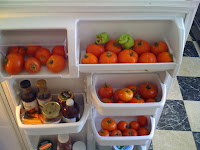
After 3 years in the bowels of the concrete jungle that is Manhattan, I have finally escaped with my fiance to the remote edge of the New York Metro region. Our new home is located in fair Riverdale, a quiet leafy, neighborhood perched along the Hudson river.
My new landlord was kind enough to give me 300 square feet of her backyard to do as I please. Sure I still have the backyard garden in Pennsylvania, but due to the distances involved, my father has been maintaining it to great effect over the last few years. So with such a generous amount of land just outside of my doorsteps, I set out at once to put it to productive use!
Firstly, I have 5 herb pots which I quickly planted with basil, cilantro, oregano, dill, and green onion chives. There were some chives from last year which was growing nicely in the fine spring weather. I collected my first handful in my new home just last night!
The soils of Riverdale seems to be very rocky. The entire area was cut out from the mountainous hillsides of the lower Hudson river. So that ruled out a conventional garden bed or even a semi-raised bed. For a bio-intensive garden capable of high yields, only rich, well-drained soil will suffice. So I set out at once to build a full raised bed garden.
I coughed up some hard currency and bought eight 6'x1' non-pressure treated oak planks. These planks were screwed together with 3 1/8' screws on each joint to form 2 large raised beds. The raised beds were then positioned on the 2 sunniest spots in my patch of land. Then the following layers of materials were placed within each raised bed:
1. 1'' of brown cardboard were placed at the bottom, this kills the grass and weeds growing on the ground beneath and attracts worms to the raised bed.
2. 1-2'' of Peat Moss were placed on top of the card board layer. The peat moss serves as a moisture retaining layer which dramatically increases the water usage efficiency of the raised bed.
3. 10'' of Top soil were placed on top of the peat moss. The top soil is medium in which the actual garden crops will be growing in.
With the two beds built, I quickly planted my stock pile of seeds and seedlings.
Raised Bed One with less such is planted with peas(Sugar Snap, Snow, Oregon Giant), onions(Walla Walla, and Georgia White), broccoli, and swiss chard.
Raised Bed Two with a few hours more worth of direct sunlight, is planted with Tomatoes(Early Girl, Beef Stead, Homestead), peppers (Yellow, Jalapeno), red onions, Summer Squash and sweet corn.






















